1. Introduction
Humans have evolved in the natural environment for millions of years and have lived in an urban industrial environment only for the last 200 years. But, unfortunately, the human race has still not well-adapted to live in the current environment.
The concept of “Biophilia” was introduced in 1984 by Edward O. Wilson in his book Biophilia. He introduced that humans have an innate, biological affinity to connect with the natural world.
In 1993 Wilson and Kellert pioneered the theory of biophilia in their book, Biophilia Hypothesis, which was the origin of discussing how to bring nature inside. Biophilic design is centered on connecting humans and nature to create a suitable formula for better health. 1
This research paper talks about how automation can play a vital role in helping support/leverage Biophilic design considerably for educational institutions.
In addition to enhancing health and livelihoods, education also promotes social stability and long-term economic prosperity. 2
2. What is Biophilic Design?
In simple words, the design that increases users' connection to nature through direct or indirect use of nature and space and place conditions is known as Biophilic design. 3Being close
1 https://en.wikipedia.org/wiki/Biophilic_design
2 https://neweralive.na/posts/opinion-government-should-invest-more-in-education
3 https://en.wikipedia.org/wiki/Biophilic_design
to nature has a profoundly positive emotional and physical influence on humans. According to research, spending time in nature natural, fake, or virtual improves physical and mental wellbeing 4
Inadequate natural light, air, greenery, vistas, environmental shapes and forms, and other developed affinities for the natural world are present in a large portion of today's constructed environment.
These ecologically deficient settings promote weariness, illness symptoms, and poor performance, which are just being uncovered. We may improve health and productivity by adding natural sunlight, outside vistas, and greenery. However, the success of a biophilic design depends on interventions that are not just temporary but also related, complementing, and incorporated into the surrounding ecosystem.
2.1.Patterns of Biophilic Design
In a study by Terrapin Bright Green 5, they combined science and psychology to establish the patterns of Biophilic Design14. Their work enlightens on the proper application of each principle while considering human requirements during design. Even if only a few rooms can be created using all the principles, a few contributing Biophilic Design components can significantly improve the well-being of a space. 6
These patterns are categorized into Nature in Space, Natural Analogues, and Nature of Space
4 https://moss.amsterdam/2021/10/07/transforming-a-conventional-workspace-with-biophilic-principles/
5 https://www.terrapinbrightgreen.com/reports/14-patterns/
6 https://blog.interface.com/identifying-14-patterns-biophilic-design/
Nature in the Space considers the design parts that give direct physical contact with nature from within an interior.
Visual Connection with Nature.
Non-Visual Connection with Nature.
Non-Rhythmic Sensory Stimuli.
Thermal & Airflow Variability.
Presence of Water.
Dynamic & Diffuse Light.
Connection with Natural Systems.
Natural Analogue patterns focus on the organic, man-made, and alluded aspects of nature in space. With these patterns, elements simulate how nature does.
Biomorphic Forms & Patterns.
Material Connection with Nature
Complexity & Order
The Nature of Space patterns specifies how humans react to the space or environment around us. Humans have an inherent need to see beyond the environment and sometimes find the unfamiliarity fascinating. We are excited and motivated by oblique vistas, design discoveries, installations, and times of suspense or danger. 7
7 https://blog.interface.com/identifying-14-patterns-biophilic-design/
Prospect Refuge Mystery
Risk/Peril
2.2.Impacts of Biophilic Design
The advantages of biophilic design rely more on interaction with nature than on singular, extraordinary, or fleeting experiences. 8This relationship must be fostered via repeated, reinforcing experiences to be beneficial. Putting this notion into practice is crucial since people have lost their fundamental connection to nature.
The WELL Building Standard® is a performance-based approach for evaluating, certifying, and maintaining built-environment elements influencing people's health and well-being in air, water, nutrition, light, fitness, comfort, and mind.
The International WELL Building Institute (IWBI), a public benefit company to enhance human health and well-being via the built environment, oversees and manages WELL. 9
Furthermore, WELL Building Standard-led efforts are becoming more widespread. As a result, research and academic inquiry are increasing, and the outcomes appear significant enough to inspire new levels of interest and enthusiasm from top research institutions and corporations.
8 https://metropolismag.com/viewpoints/what-is-and-is-not-biophilic-design/
9 https://www.usgbc.org/articles/what-well
Below are the statistics for how biophilic design can improve our well-being: 10
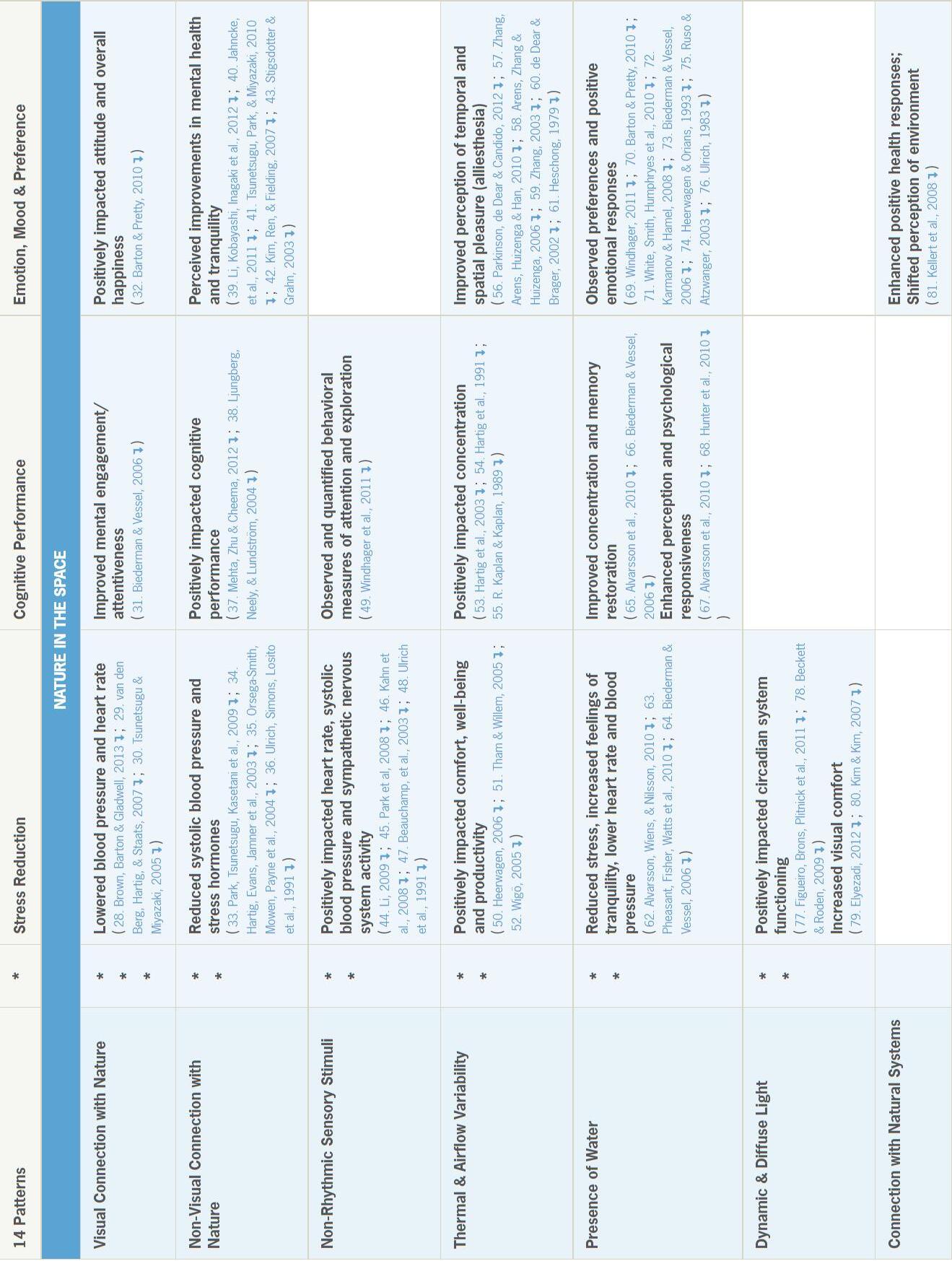
10 https://www.terrapinbrightgreen.com/reports/14-patterns/
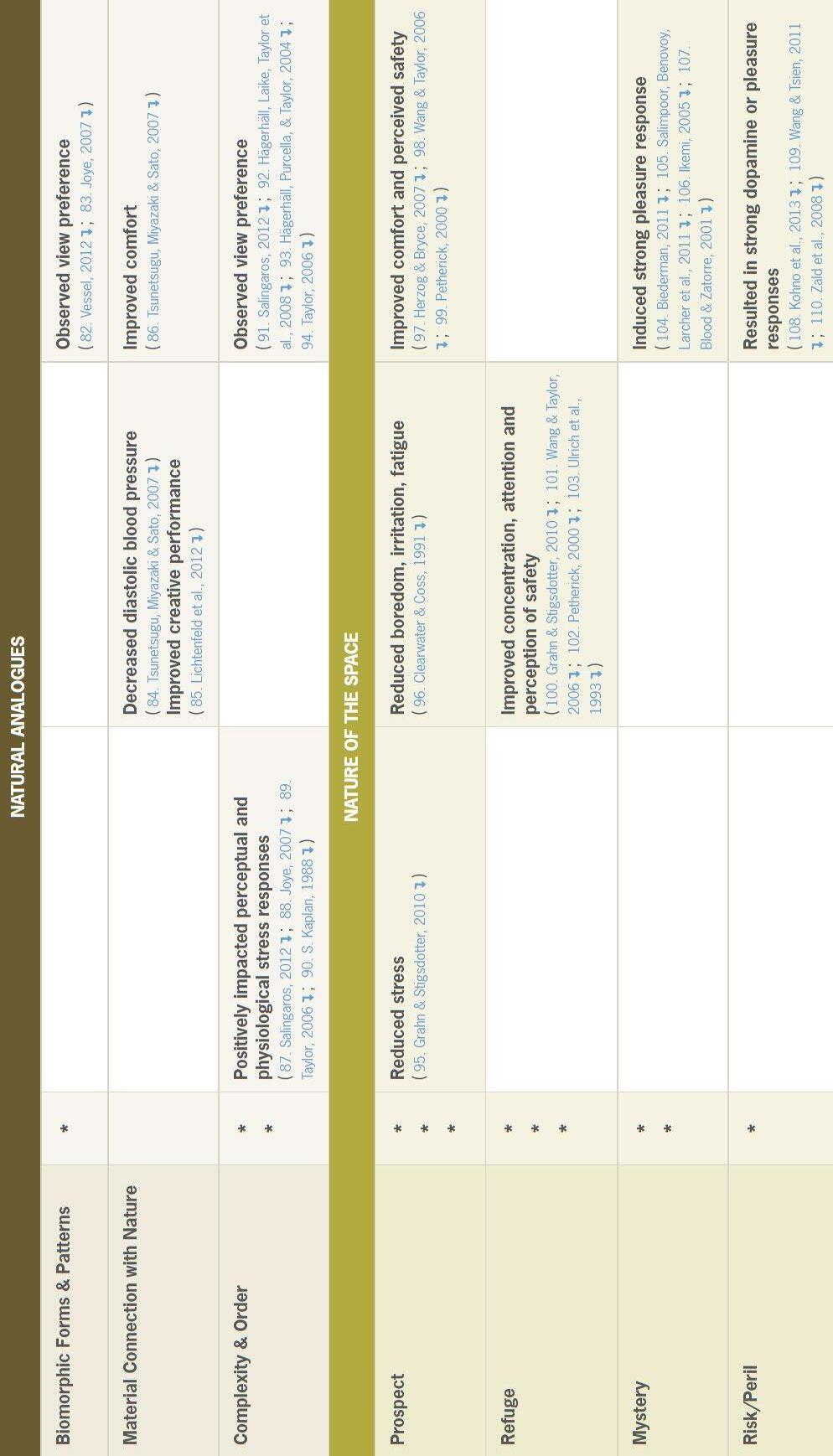
3. Impacts of Biophilic Design on Educational Buildings
According to research, including nature in learning spaces can significantly impact students' cognitive function and emotional health. Lack of natural nurturing puts traits associated with ADHD, shorter attention spans, and diminished focus at risk.
Increased attendance, improved conduct, higher test scores, lower stress, and greater focus are critical learning advantages that biophilic classroom design offers.
Sensory and motor development are required to engage the five senses and solve problems. Including sensory components from the environment helps encourage students' curiosity, creativity, and sense of discovery.

A study 11 examined how school teaching environments and the student's ideal teaching environment are related. A survey was created to investigate the learning environments in schools. The survey recorded the students' thoughts on the ideal classroom and how biophilic elements relate to it. The formulation of workable requirements that support developing the educational environment was based on theoretical and practical considerations for the results. Some excellent ideas include increasing sunshine through a sizable number of windows and adjusting lighting, color, and intensity with intelligent devices.
In order to provide a more effective and healthy learning environment, bio-designed buildings incorporate natural lighting and ventilation, natural landscape features, and other aspects. Unfortunately, our modern lifestyle has cut itself off from and lost touch with the natural environment.
New school construction in Connecticut, Sandy Hook Elementary School, has implemented a biophilic design that uses light and a connection to nature to lessen stress and enhance creativity. Their classrooms have large windows so kids may see outdoors, but nobody else can see inside. In addition, a rain garden surrounds the school building. Here are the biophilic elements and their impact on specific areas.
According to a study on the effects of daylight, light levels significantly impact students' performance and vision in the classroom. Unfavorable lighting can skew the information a pupil learns through their eyes, increasing the chance that they will lose their vision for the duration of the lesson.
11 https://www.hindawi.com/journals/ace/2022/8545787/
A functional learning environment with elements of nature from water, green, and air will excite students and activate them with more creative mental powers.
Colors can induce feelings. Although color effects are universal in perception, color sensations are typically subjective.
The functional rather than the aesthetic components of color selection should be stressed when selecting colors for learning environments. Color overstimulation leads to sensory overload. For example, children's readiness to collaborate is influenced by the walls' color and the ceiling height in their rooms.
Establishing a clear and objective link between students' aspirations for a positive educational experience and the fundamental research needed to provide a welcoming learning environment is essential.
Jim Determan, FAIA, speaks to investigative reporter Eric Flack. of WUSA9 in Washington, DC, on biophilic design and school safety. Jim Determan stated, "If there is a way to make students feel better; and not get to a point where they are going to cause bullying or aggression or violence, let us take that route. Let us make that part of the solution." 12
If the schools are designed like this typical institutional buildings like prisons, naturally, one could anticipate students behaving like prisoners. 13
With the biophilic design, spaces are more open, and fewer places to hide, and there will be less bullying and microaggressions, which affects far more children in schools.
12 https://cgdarch.com/biophilic-design-school-safety/
13 https://www.wusa9.com/article/news/local/experts-windows-light-gardens-a-better-way-to-stop-schoolshooters/65-608367706?fbclid=IwAR3A3eNvUJukAbTgpYCVgBBlYmlbaN1EMowjsGKLL6zZ4r HKvDdBVkInEw
4. Drawbacks Of Biophilic Design & how automation can help
Despite the vast advantages of biophilic design, there are a few minor drawbacks. Often people refrain from embracing the elements of biophilic design due to budget and time constraints.
4.1.What factors add cost to biophilic design
Adding plenty of plants is a common misperception about biophilic design, but it is far more intricate than that. 14
A well-kept, freshly watered plant on a desk or a couple of succulents on the coffee table would encourage one’s interaction with nature. However, these are not elements of Biophilic design. Such sporadic instances of nature do nothing to connect one to the outdoors, and biophilia is not about a few plants. Hence, incorporating more elements of biophilia and maintenance can add cost. 15
Building a biophilic structure from scratch requires more funding than conventional structures time-consuming for planning and execution compared to traditional design approaches that add cost.
Automation can reduce costs in unexpected ways like eliminating unknown problems. For example - As simple as identifying a problem in the plant and preventing the plant from dying.
14 https://k2space.co.uk/knowledge/biophilic-office-design/
15 https://www.re-thinkingthefuture.com/architectural-facts/a4462-6-things-you-did-not-know-about-biophilicdesign/
Automation can also help reduce the cost of raw materials by reducing waste. When it comes to many industrial processes, such as portioning, machines are more accurate than people. Less variance = less waste = more savings. 16
As of November 12, 2022, According to this report by The National Alliance of Mental Health, one-fifth of adults in America experience a mental illness in their lifetime. Currently, nearly 10 million Americans live with severe mental disorders, the most common being anxiety disorders, major depression, and bipolar disorder. 17 Frequent and routine contact with nature through careful design triggers the relaxation of tensed muscles and lowers blood pressure and stress hormone levels in the blood. However, people with anxiety have feelings that interfere with day-to-day activities and are hard to manage. 18 Adding tasks to maintain biophilic design can be overwhelming and negate biophilic design's benefits.
Finally, converting an existing structure not designed with biophilia in mind could be difficult. Working with the existing structure can be quite a challenge, sometimes impossible. This is where automation comes in.
Another example is clearing dried leaves or cleaning the aquarium; all require labor expenses and take time. With the help of an automated system like an automatic vacuum machine that can water and clean the dead leaves would be helpful. For example, an automated watering system can identify the moisture level and water whenever needed. So, we can avoid over-watering and save water.
16 https://garvey.com/4-ways-automating-production-line-reduces-costs/
17 https://www.achn.net/about-access/whats-new/health-resources/3-most-common-mental-health-disorders-inamerica/
18 https://www.mayoclinic.org/diseases-conditions/anxiety/symptoms-causes/syc-20350961#
5. Potential Solutions
With all information gained in the above case studies and research, it is evident that with the help of automated technology, we can make the biophilic design more accessible and easier to maintain, which would encourage more people to pursue biophilic design.
All-encompassing technology is our reality, whether it is the requirement for biophilic design or a component that promotes it (or both).
In recent research, the AMA (American Medical Association) Council revealed that both natural and artificial light that is in synchrony with natural circadian cycles promotes better physiological functioning and feelings of well-being. In addition, we now have access to cuttingedge items that can simulate and harness natural light thanks to new technologies. 19
Automated architectural louvers that follow the sun's path can be installed on window exteriors to regulate the flow of natural light and air while preserving comfortable temperatures and views of the environment. Likewise, to keep that connection to natural light and biophilic vistas, dynamic glass that blocks out direct sunlight can be utilized in place of curtains or shades. It is also being utilized in lighting design to create light systems that mirror our natural circadian rhythms, the 24-hour cycle of internal physiological processes influenced by light and temperature. To work with rather than against people's circadian rhythms, designers use adjustable white light LEDs that provide the complete spectrum of natural daylight color temperatures, including bright daylight.
19 https://www.mkda.com/news/striking-the-perfect-balance-technology-in-biophilic-hotel-design/
Gardens, imposing forests, and vibrant meadows have been places humans always have been drawn to. The popularity of living walls is also growing, but automated watering systems are essential for these vertical gardens to be successful. Installations of living walls are taking place in a variety of constructed contexts because of their numerous advantages.
In addition, interior gardens eliminate dangerous contaminants and release pure oxygen that, due to perspiration, can even lower ambient temperatures. Humans have omnidirectional hearing; thus, they can hear everything around them. However, when noise levels reach a toxic level, we suffer from elevated blood pressure and stress. We may activate the fight-or-flight response, a holdover from our earliest human ancestors. Nature noises can make us feel calm and relaxed, while living walls can aid with sound absorption and acoustics. The sounds of water are considered to be the most comforting to humans. The soothing sounds of a babbling stream can influence healthy systemic changes and give us a sense of security, grounding, and connection to nature. Using technology to automate different nature sounds based on the students' emotions could be a great way to add nature sounds.
Scent has a strong influence. It profoundly impacts our well-being and persists in the memory longer than any other sensory experience. Therefore, spaces should automatically integrate nature-inspired aromatherapy into their environments based on the need to create a distinctive biophilic experience.
The unpredictable, chaotic, and varied aspects of the natural world should be welcomed and appreciated in human-designed spaces. It might be a good idea for architects and designers to take a topographically-based approach to space planning. For example, layouts may include surface areas that imitate winding trails, tall hills and plateaus, vast open meadows, and quiet,
cozy nooks and crannies. Air systems can regulate temperature and airflow to simulate an external breeze for users.
Technology-based interactive art is becoming more popular. The world of art is changing due to these "digital paintings." A “digital painting" that moves to influence people's respiration on an unconscious level is one example of a biophilic design application. Breathing slows down as a result of viewing art, putting viewers in a relaxed, peaceful condition.
Emotion-sensing technology has given rise to a design methodology that monitors and analyzes behavior patterns and measures action, body language, voice modulation, and facial expressions. As a result, smart technology will be able to understand the significance of various emotions and react appropriately. This information would open a world of opportunities to enhance human living conditions.
6. Proposed Solution
Here is a proposal for an educational institution design using biophilia and automation.
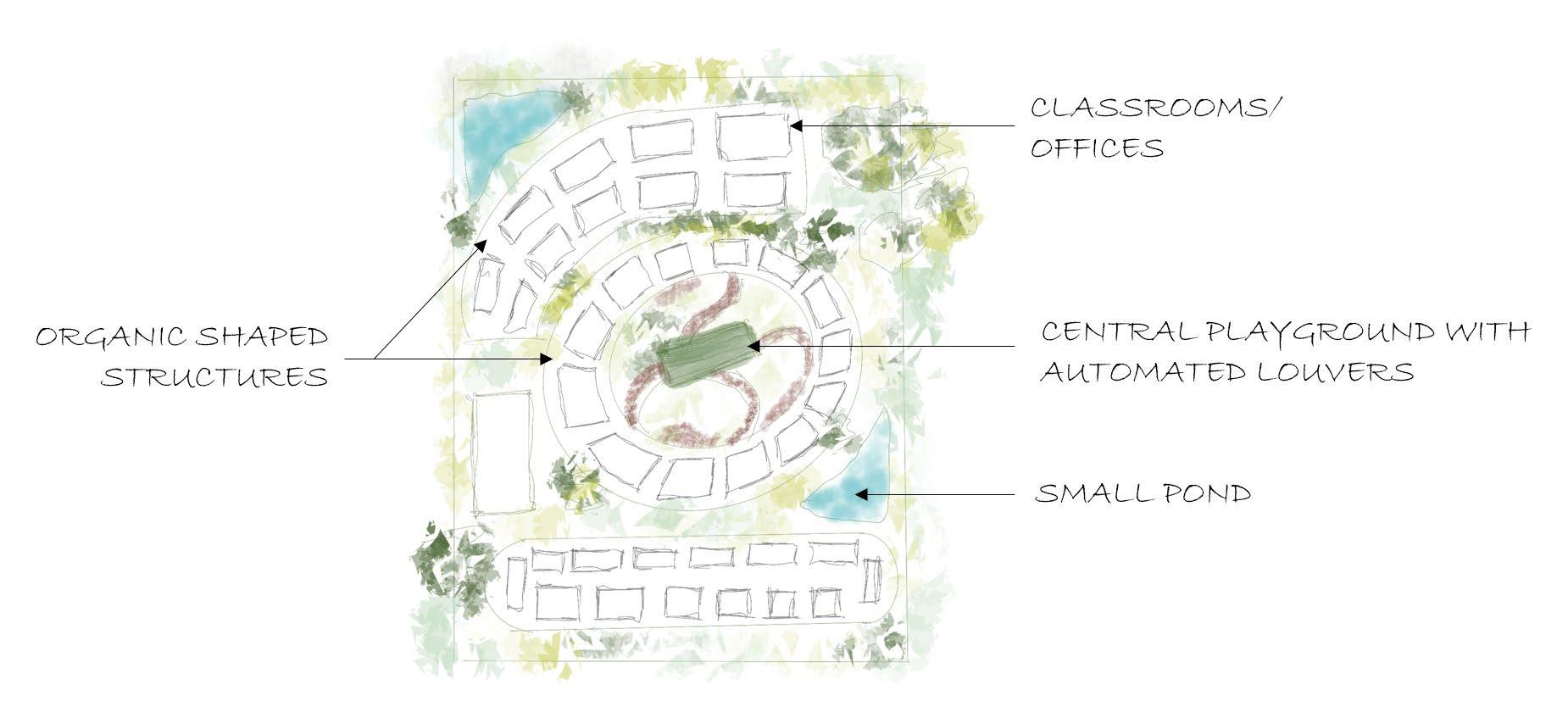
Suspended ceiling LED panels with varying heights mimicking realistic skies. These panels are automated to turn on or off or change the animated images displayed. With the help of a controller, weather data is collected, and based on that; these panels can display exact weather in the real world outside.
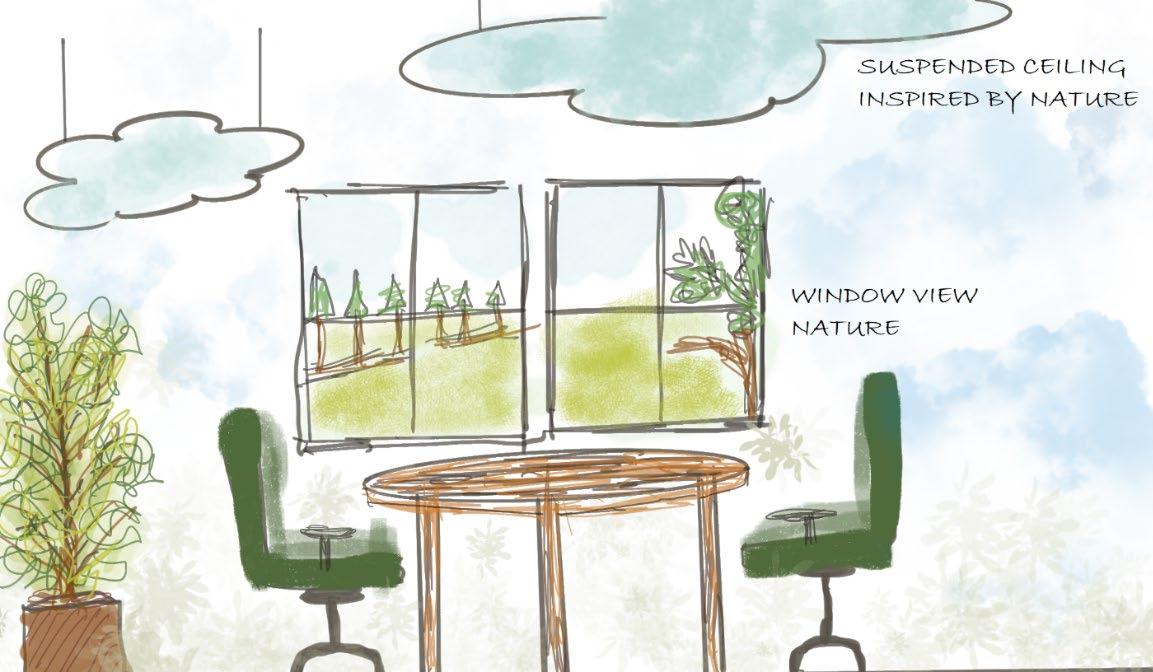
Illustration: Common reading areas SkyFactory LED panels used in this school design suspended the room ceiling to mimic real skies.
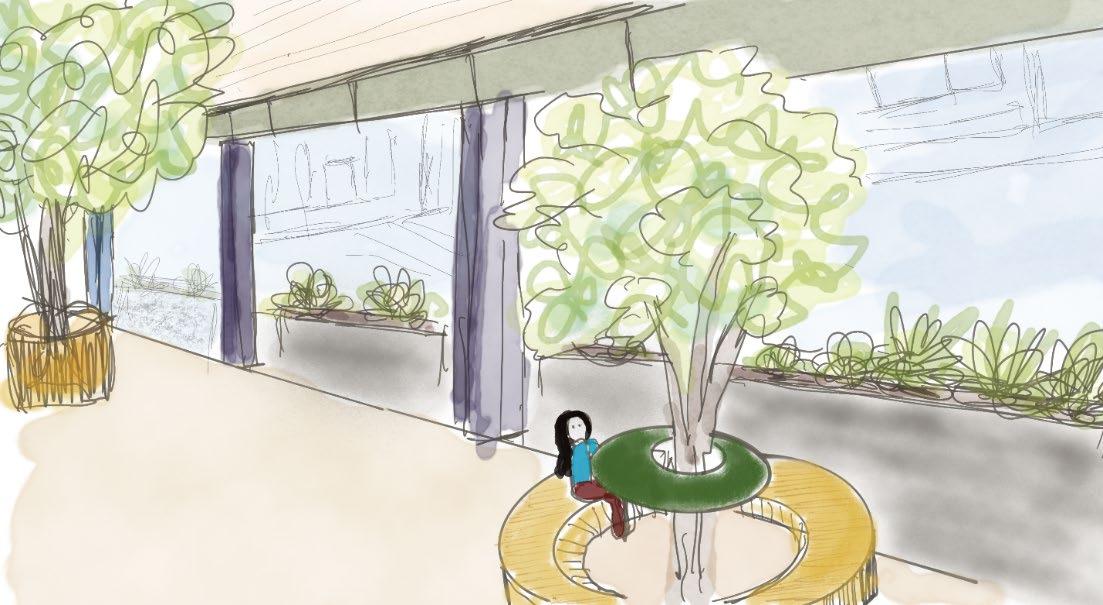
Illustration: Common areas with biophilic elements where students can work and/or relax
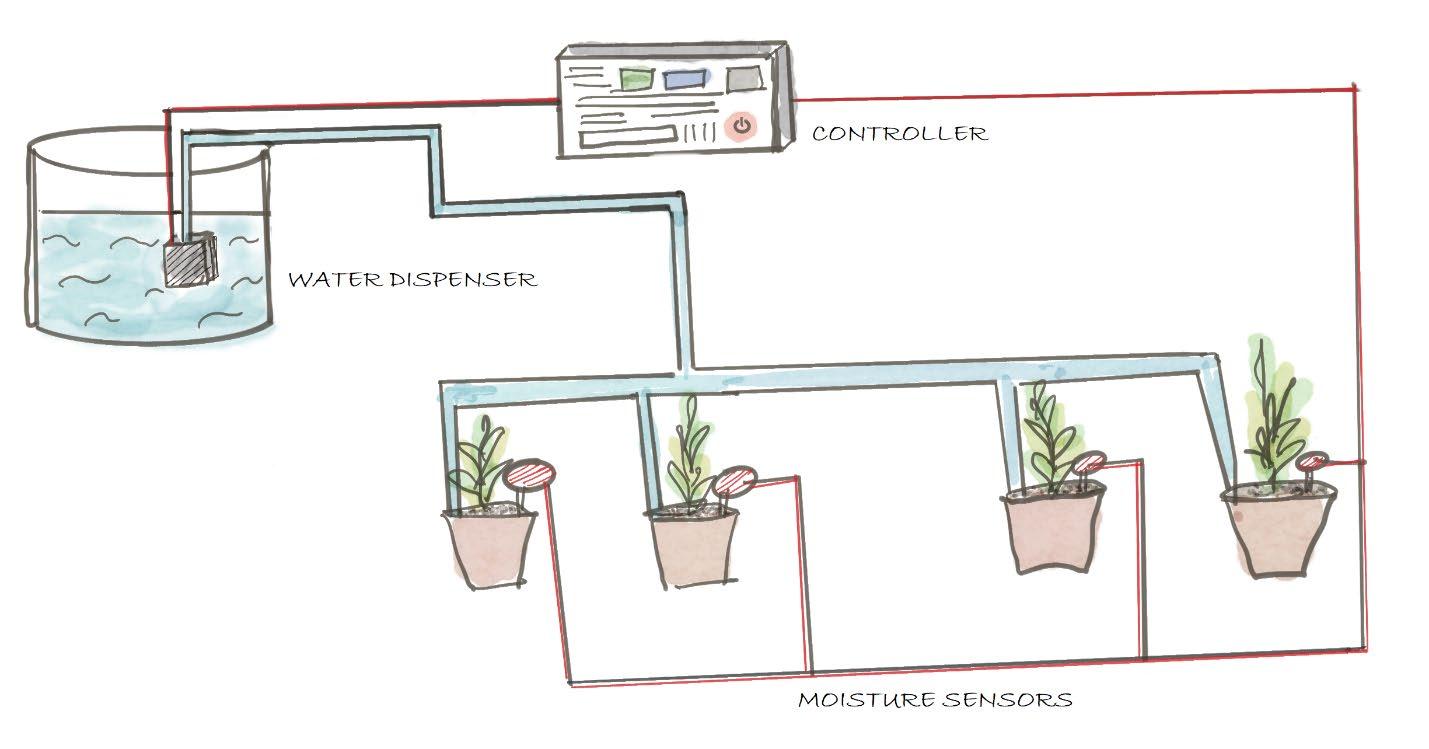
Illustration: An automated watering system with moisture detection control
This automated system is built with moisture sensors in all the plant pots, and the data is sent to the controller. The controller, after processing this data, identifies which plant requires watering. Based on that, the quantity of water will be dispensed to the plants.
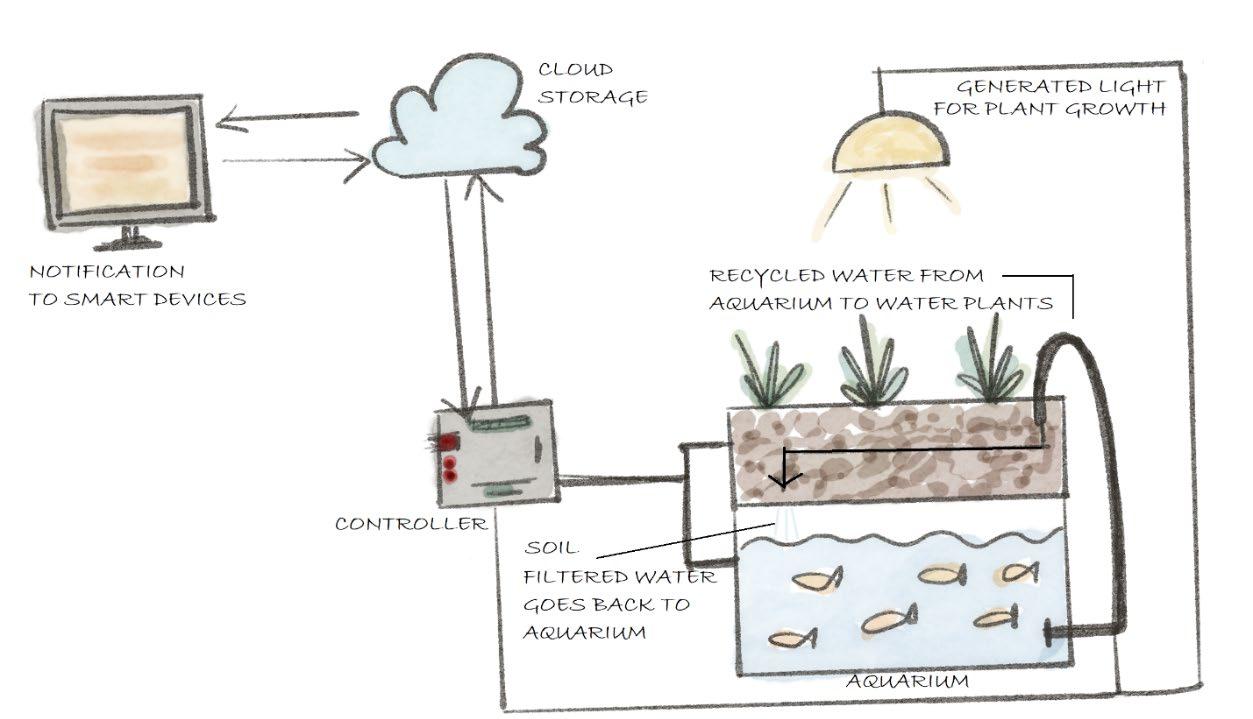
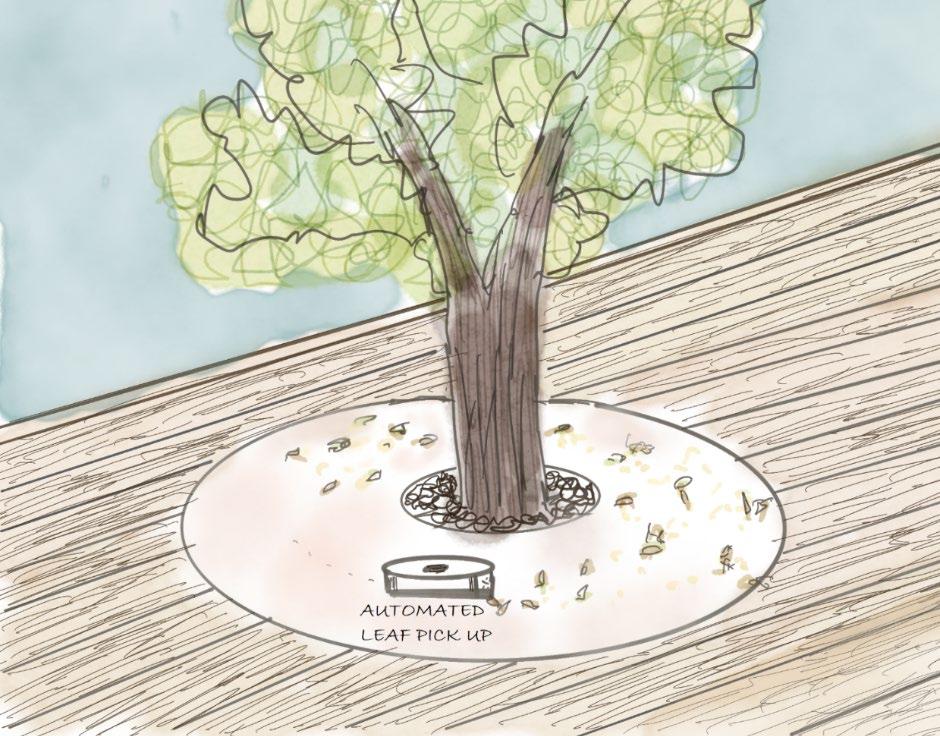
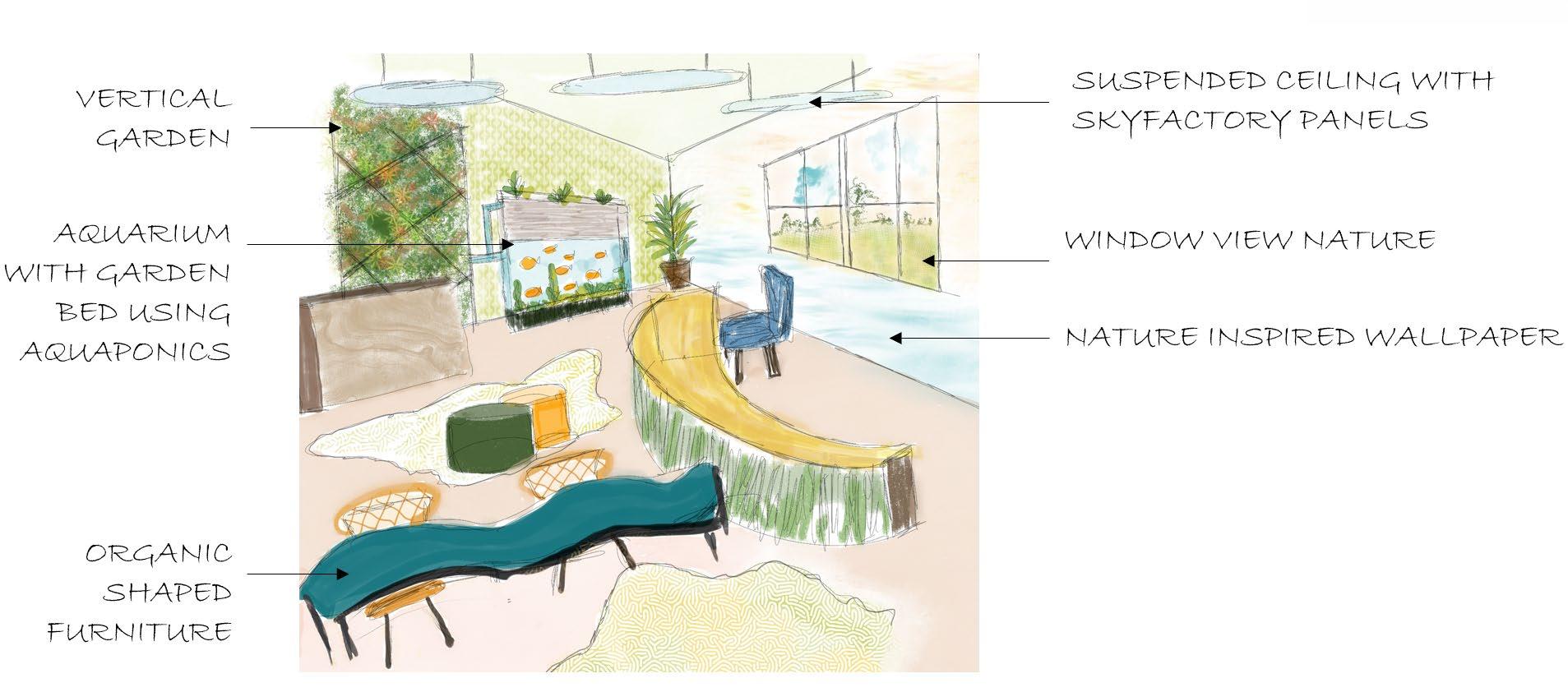
7. Conclusion
The divide between humans and nature is constantly growing and seriously affects our physical and mental health. The impact of Biophilic design on Education institutes which are often discarded could have a more considerable positive impact. Unfortunately, due to the cost of maintainability, such design has made little progress over the years. However, technology could help in better-integrated solutions while addressing difficulties faced by such a structure. Automation is one of the pillars of creating better integrated biophilic elements in this rapid urbanization environment. Thus, creating stronger connections between humans and nature, eventually promoting good health, which weighs all other factors.
8. References
• https://www.inprocorp.com/resources/blog/biophilic-design-in-education
• https://www.hindawi.com/journals/ace/2022/8545787/
• https://www.wusa9.com/article/news/local/experts-windows-light-gardens-a-better-wayto-stop-school-shooters/65-608367706?fbclid=IwAR3A3eNvUJukAbTgpYCVgBBlYml baN1WEMowjsGKLL6zZ4rHKvDdBVkInEw
• https://www.mkda.com/news/striking-the-perfect-balance-technology-in-biophilic-hoteldesign/
• https://www.terrapinbrightgreen.com/reports/14-patterns/
• https://www.skyfactory.com/https://hmcarchitects.com/news/how-modern-school-designcan-reduce-bullying-2018-09-14/
• https://www.parentingspecialneeds.org/article/biophilic-design-can-benefit-people-withspecial-needs/https://https://www.architectmagazine.com/technology/7-ways-to-enhanceindoor-environments-with-biophilic-design_o
• handelarchitects.com/case-study/inspir-carnegie-hill-case-study
• https://smart-cre.com/what-is-biophilic-architecture-buildings-inspired-by-nature/
• https://metropolismag.com/viewpoints/what-is-and-is-not-biophilic-design/
• https://www.terrapinbrightgreen.com/reports/14-patterns/
• https://www.ambius.com/blog/why-biophilia-matters/
Special thanks to Joy Pontrello, Designer, Joy Interiors
SkyFactory Inc.
Ms. Lisa Nienhaus, Instructor, Madison Area Technical College
